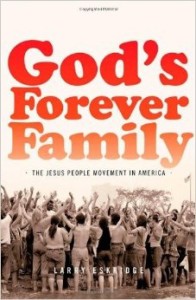 Larry Eskridge’s God’s Forever Family is a fascinating look at one of the more intriguing movements within American Christianity: the Jesus People. Beginning in the late 1960’s in California, the Jesus People began as a movement of Christian kids who identified with the hippie culture of the time as well as hippie kids who embraced the gospel as it was being presented in culturally relevant, fresh, attractive, and often controversial ways. Eskridge tells of the movement’s origins in the Haight Ashbury area of San Francisco, of its geographical expansion, and of the colorful characters that played key roles in the movement’s advance, evolution, and, at times, missteps.
Larry Eskridge’s God’s Forever Family is a fascinating look at one of the more intriguing movements within American Christianity: the Jesus People. Beginning in the late 1960’s in California, the Jesus People began as a movement of Christian kids who identified with the hippie culture of the time as well as hippie kids who embraced the gospel as it was being presented in culturally relevant, fresh, attractive, and often controversial ways. Eskridge tells of the movement’s origins in the Haight Ashbury area of San Francisco, of its geographical expansion, and of the colorful characters that played key roles in the movement’s advance, evolution, and, at times, missteps.
It is a story of indisputably passionate zeal for the gospel of the Christ. At its best, the Jesus People introduced an enthusiasm for sincere, relevant worship and modeled a stunning boldness in evangelistic witness. At its worst, it was a movement high on zeal but, occasionally, low on doctrinal foundations. This made the movement at times susceptible to charismatic false teachers or ideas that could lure segments of these predominantly young people away from biblical truth and orthodoxy.
One of the major and, personally, most challenging aspects of the story was the way in which established churches responded to the movement. At times, they did so admirably. Though I would want to add some cautions, I think that Chuck Smith and Calvary Chapel should be commended for having a great burden for these young people. At other times, the established churches did not respond well. I cringed to read accounts of established churches turning up their noses at these young people and their unconventional ways of speaking and dressing. Eskridge quotes one elderly church lady’s response to being asked if she could help house a homeless young hippie. After looking at the young man with his disheveled and unclean appearance, she responded, “That dirty thing between my clean sheets?!” In a microcosm, that was the general response and mindset of the churches that refused to engage these young people.
Other important and very interesting aspects of the story include the birth of contemporary Christian music out of the Jesus People movement, the hijacking of certain elements of the Jesus People by David Berg’s Children of God cult, Billy Graham’s admirable openness to and championing of the Jesus People, the eastward and even international expansion of the Jesus People with greater or lesser success (depending on numerous regional factors), the communal living experiments among many of the Jesus People, and the numerous testimonies of Christians attesting to just how powerfully God moved and worked in and through this movement.
Whether you are familiar with this movement or not, you will benefit from this very well-written, extremely informative, and wonderfully engaging book.
